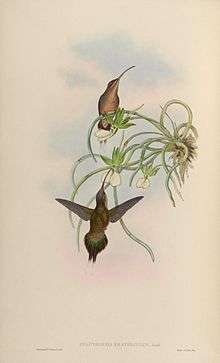Long-tailed hermit
| Long-tailed hermit | |
|---|---|
 | |
| Scientific classification | |
| Kingdom: | Animalia |
| Phylum: | Chordata |
| Class: | Aves |
| Order: | Apodiformes |
| Family: | Trochilidae |
| Genus: | Phaethornis |
| Species: | P. superciliosus |
| Binomial name | |
| Phaethornis superciliosus (Linnaeus, 1766) | |
The long-tailed hermit (Phaethornis superciliosus) is a large hummingbird that is a resident breeder in Venezuela, the Guianas, and north-eastern Brazil. This species is commonly referred to as the eastern long-tailed hermit, but it is likely, following recommendations from Gary Stiles in February 2006, that the new name will be adopted by most authorities.
The taxonomic history of this group is complicated, with similar hermit populations from both sides of the Andes being originally classed as a single long-tailed hermit species. The western population was then split as the western long-tailed hermit, P. longirostris, leading to the renaming of P. superciliosus as eastern long-tailed hermit. The further renaming of P. longirostris as long-billed hermit means that P. superciliosus no longer needs “eastern” in its English name.
A further problem relates to the taxonomy of the long-tailed hermit versus the great-billed hermit (P. malaris). Most taxa previously consider subspecies of the former (insolitus, moorei, ochraceiventris, bolivianus and margarettae) are now considered subspecies of the latter. A satisfactory taxonomic treatment of the entire P. longirostris/P. superciliosus/P. malaris group is still lacking according to some Neotropical ornithologists.
The long-tailed hermit inhabits forest undergrowth, usually near water and its preferred food plants. It is 13.5 cm long and weighs 4-6 g. The bill is very long and decurved (3.6-4.3 cm), with a red tipped black lower mandible, and the central feathers of the tapered tail are long (6.3-6.8 cm) and white-tipped.
The adult long-tailed hermit is mainly dull brownish green above with a buff-tinged rump. It has a dark mask through the eye, bordered above and below with whitish-buff stripes. The underparts are pale greyish-buff in colour. The sexes are similar, although the female is slightly smaller.
During the breeding season, male long-tailed hermits sing in communal leks of up to several dozen birds, and also wiggle their long tails in display. Competitive lek singing can occupy half of the daylight hours, the purpose of course being to attract females. The female selects the best lek singer to mate with. The song consists of sharp tsuk sounds.
The female long-tailed hermit is solely responsible for nest construction, incubation and feeding the young. She lays two white eggs in a conical nest of fibres and cobwebs suspended under a large Heliconia or banana leaf.
The food of this species is nectar, taken from large flowers, such as Heliconias, gingers and passion flowers, and small insects and spiders taken as an essential source of protein. Hatchlings are fed by the female with regurgitated invertebrates.
Long-tailed hermits are trap-line feeders; they do not defend territory, but visit seasonal flowers on routes through the forest up to I km long.
External links
| Wikimedia Commons has media related to Phaethornis superciliosus. |
- ^ "Proposal (#205) to South American Classification Committee". Retrieved 2006-03-11.
- ^ "Proposal (#178) to South American Classification Committee". Archived from the original on 2007-02-23. Retrieved 2007-07-04.
- "Eastern long-tailed hermit" videos on the Internet Bird Collection
- Stamps (for Guyana, Suriname) with RangeMap
- Long-tailed hermit photo gallery VIREO Photo-High Res-(Close-up)
References
- ↑ BirdLife International (2012). "Phaethornis superciliosus". IUCN Red List of Threatened Species. Version 2013.2. International Union for Conservation of Nature. Retrieved 26 November 2013.
- Hilty, Birds of Venezuela, ISBN 0-7136-6418-5
- Hinkelmann, C. (1999). Eastern Long-tailed Hermit (Phaethornis superciliosus). pp. 541 in: del Hoya, J., Elliott, A. & Sargatal, J. eds (1999). Handbook of the Birds of the World. Vol. 5. Barn-owls to Hummingbirds. Lyxn Edicions, Barcelona. ISBN 84-87334-25-3
